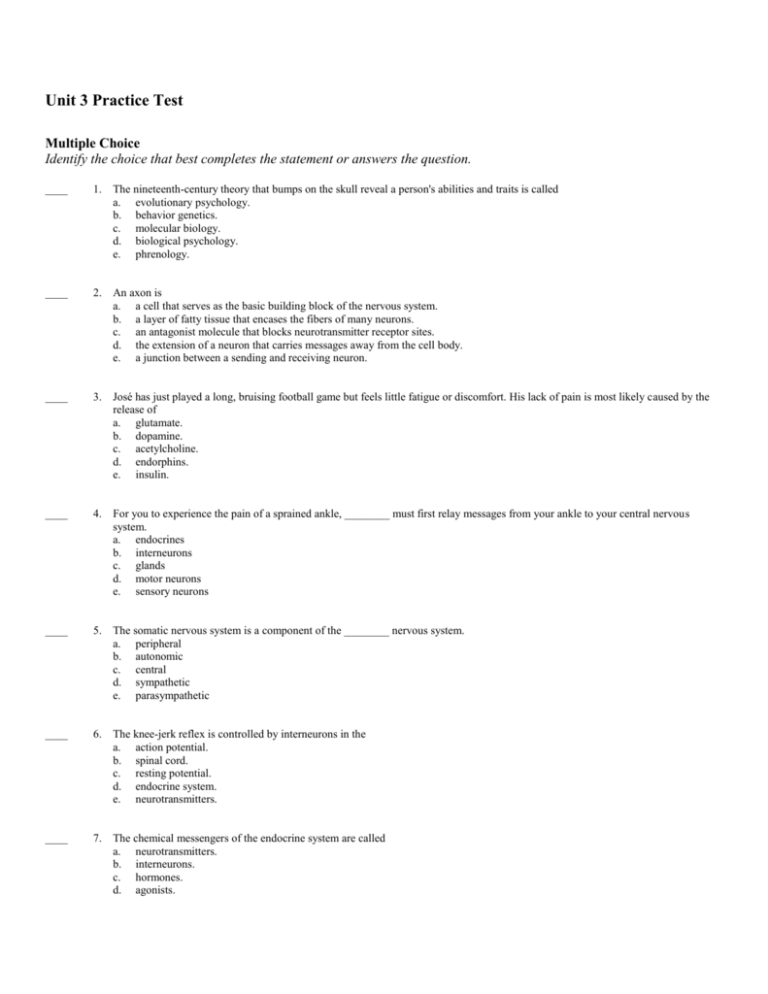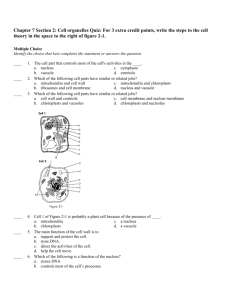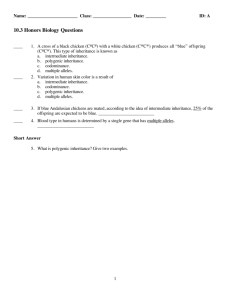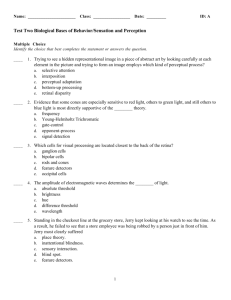Unit 3 Practice Test and Key
advertisement

Unit 3 Practice Test Multiple Choice Identify the choice that best completes the statement or answers the question. ____ 1. The nineteenth-century theory that bumps on the skull reveal a person's abilities and traits is called a. evolutionary psychology. b. behavior genetics. c. molecular biology. d. biological psychology. e. phrenology. ____ 2. An axon is a. a cell that serves as the basic building block of the nervous system. b. a layer of fatty tissue that encases the fibers of many neurons. c. an antagonist molecule that blocks neurotransmitter receptor sites. d. the extension of a neuron that carries messages away from the cell body. e. a junction between a sending and receiving neuron. ____ 3. José has just played a long, bruising football game but feels little fatigue or discomfort. His lack of pain is most likely caused by the release of a. glutamate. b. dopamine. c. acetylcholine. d. endorphins. e. insulin. ____ 4. For you to experience the pain of a sprained ankle, ________ must first relay messages from your ankle to your central nervous system. a. endocrines b. interneurons c. glands d. motor neurons e. sensory neurons ____ 5. The somatic nervous system is a component of the ________ nervous system. a. peripheral b. autonomic c. central d. sympathetic e. parasympathetic ____ 6. The knee-jerk reflex is controlled by interneurons in the a. action potential. b. spinal cord. c. resting potential. d. endocrine system. e. neurotransmitters. ____ 7. The chemical messengers of the endocrine system are called a. neurotransmitters. b. interneurons. c. hormones. d. agonists. e. antagonists. ____ 8. Epinephrine and norepinephrine are released by the a. thyroid gland. b. pituitary gland. c. parathyroids. d. adrenal glands. e. pancreas. ____ 9. Surgical destruction of brain tissue is called a(n) a. endorphin. b. EEG. c. synapse. d. lesion. e. MRI. ____ 10. What is the main difference between an MRI scan and an fMRI scan? a. MRI scans are able to show internal structures of the brain, fMRI scans can also show external structures. b. MRI scans use X-rays, fMRI scans use gamma rays. c. MRI scans measure glucose levels in the brain, fMRI scans measure oxygen levels. d. MRI scans show structural details of the brain, fMRI scans show structure and activity levels. e. MRI scans measure brain wave activity, fMRI scans use a series of X-ray images to show structural details. ____ 11. Your ability to experience physical sensations is most likely to be disrupted by damage to your a. corpus callosum. b. angular gyrus. c. hippocampus. d. amygdala. e. thalamus. ____ 12. Which brain structure receives information from all the senses except smell? a. hippocampus b. amygdala c. pons d. thalamus e. medulla. ____ 13. The secretions of the pituitary gland are most directly regulated by the a. reticular formation. b. hypothalamus. c. amygdala. d. cerebellum. e. thalamus. ____ 14. Nerve cells in the brain receive life-supporting nutrients and insulating myelin from a. glial cells. b. neurotransmitters. c. motor neurons. d. hormones. e. sensory neurons. ____ 15. The occipital lobes are to ________ as the temporal lobes are to ________. a. hearing; sensing movement b. seeing; sensing touch c. d. e. sensing pleasure; sensing pain seeing; hearing speaking; hearing ____ 16. To trigger a person's hand to make a fist, José Delgado stimulated the individual's a. motor cortex. b. hypothalamus. c. sensory cortex. d. reticular formation. e. limbic system. ____ 17. While mapping the motor cortex, researchers Foerster and Penfield found that a. although the mind's subsystems are localized in specific brain regions, the brain acts like a unified whole. b. damage to a specific area in the left frontal lobe disrupted speech ability. c. body areas requiring the greatest control occupied the greatest amount of cortical space. d. if one part of the brain is damaged, the brain will compensate by putting other areas to work. e. our brain processes most information out of our awareness. ____ 18. A PET scan of a patient looking at a photograph of a painting would most likely indicate high levels of activity in which brain structure? a. sensory cortex b. Broca's area c. corpus callosum d. occipital lobes e. frontal lobes ____ 19. The most extensive regions of the cerebral cortex, which enable learning and memory, are called the a. reticular formation. b. medulla. c. sensory areas. d. cerebellum. e. association areas. ____ 20. When asked to describe a picture that showed two boys stealing cookies behind a woman's back, a patient replied, “Mother is away her working her work to get her better, but when she's looking the two boys looking the other part.” Which brain region has most likely been damaged? a. Broca's area b. angular gyrus c. corpus callosum d. Wernicke's area e. parietal lobes ____ 21. If a blind person uses one finger to read Braille, the brain area dedicated to that finger expands as the sense of touch invades the visual cortex. This is an example of a. brain plasticity. b. hemispheric specialization. c. neural prosthetics. d. integrated association areas. e. aphasia. ____ 22. The capacity of one brain area to take over the functions of another damaged brain area is known as brain a. tomography. b. phrenology. c. hemispherectomy. d. aphasia. e. plasticity. ____ 23. Teaching a patient to regain the use of an impaired limb by limiting his or her use of the good limb is called a. functioning magnetic resonance imaging. b. constraint-induced therapy. c. neural prosthetics. d. phrenology. e. cognitive neuroscience. ____ 24. After Terry lost a finger in an industrial accident, the area of his sensory cortex devoted to receiving input from that finger gradually became very responsive to sensory input from his adjacent fingers. This best illustrates a. phrenology. b. aphasia. c. hemispherectomy. d. plasticity. e. tomography. ____ 25. A picture of a dog is briefly flashed in the left visual field of a split-brain patient. At the same time a picture of a boy is flashed in the right visual field. In identifying what she saw, the patient would be most likely to a. use her left hand to point to a picture of a dog. b. verbally report that she saw a dog. c. use her left hand to point to a picture of a boy. d. verbally report that she saw a boy. e. communicate that she saw a picture of a boy with a dog. ____ 26. Which brain structure might be most active when answering the question “What do the following words have in common: plane, butter, insect?” a. amygdala b. reticular formation c. brainstem d. left hemisphere e. right hemisphere ____ 27. Research on left-handedness suggests that a. genes or prenatal factors play a role in handedness. b. a greater proportion of women than men are left-handed. c. left-handers generally demonstrate less artistic competence than right-handers. d. most left-handers process language primarily in their right hemisphere. e. left-handers live longer than right-handers. ____ 28. What is the interdisciplinary study of how brain activity is linked with our mental processes called? a. social-cultural perspective b. psychodynamic perspective c. cognitive neuroscience d. industrial-organizational psychology e. biopsychosocial approach ____ 29. Someone skilled at word processing thinks several letters ahead while typing, whereas a beginner must focus on one letter at a time. A novice is most likely using _________ to complete the task. a. conscious serial processing b. the right hemisphere c. the limbic system d. unconscious parallel processing e. the reticular formation ____ 30. Which cognitive neuroscience term reflects the idea that “much of our everyday thinking, feeling, and acting operates outside our conscious awareness”? a. dual processing b. cerebral cortex c. reticular formation d. interneurons e. limbic system ____ 31. The study of the relative power and limits of genetic and environmental influences on behavior and personality traits is known as a. epigenetics. b. evolutionary psychology. c. behavior genetics. d. natural selection. e. genome research. ____ 32. When people discuss the “nature vs. nurture” controversy, Nature refers to ________ and Nurture refers to ________. a. genes; heredity b. chromosomes; genetics c. biology; environment d. DNA; hormones e. thinking; behavior ____ 33. DNA is a complex a. sex hormone. b. action potential. c. molecule. d. synapse. e. neuron. ____ 34. The biochemical units of heredity that make up the chromosomes are called a. genes. b. genomes. c. epigenetics. d. neurotransmitters. e. heredity. ____ 35. Depending on environmental conditions, specific genes can be either a. nature or nurture. b. active or inactive. c. identical or fraternal. d. chromosomes or genomes. e. sperm or eggs. ____ 36. Fraternal twins originate from the fertilization of a. a single egg cell by a single sperm cell. b. two egg cells by a single sperm cell. c. a single egg cell by two sperm cells. d. two egg cells by two sperm cells. e. a divided egg cell and one sperm cell. ____ 37. Who are likely to show the greatest similarity in personality? a. Ruth and Ramona, identical twins b. Philip and Paul, fraternal twins c. Larry and Laura, brother and sister d. e. Vincent Sr. and Vincent Jr., father and son Elizabeth and Betsy, mother and daughter ____ 38. An African butterfly that is green in the summer turns brown in the fall thanks to a temperature-controlled genetic switch. This best illustrates that genes are a. DNA. b. self-regulating. c. chromosomes. d. protein molecules. e. evolving. ____ 39. Many genes respond to environmental conditions, reacting to different environmental contexts in different ways. This characteristic of genes is called what? a. chromosomes b. genotype c. heritability d. self-regulation e. evolution ____ 40. People have always responded so positively to Alyssa's good looks that she has developed a socially confident and outgoing personality. This best illustrates a. the impact of personality on gender identity. b. that ideas about gender and social roles are complementary. c. the interaction of nature and nurture. d. the reciprocal influence of norms and roles. e. the importance of nurture rather than nature. ____ 41. Epigenetics refers to the a. influences that affect our mating decisions. b. factors that trigger us to behave aggressively towards others. c. the study of how men and women respond to sex hormones. d. the way that genes solely create our personalities. e. the study of how the environment triggers genetic expression. ____ 42. Evolutionary psychologists emphasize that environmentally adaptive behaviors are those that have promoted a. reproductive success. b. personal happiness. c. cultural diversity. d. heritability. e. behavior genetics. ____ 43. If a genetic predisposition to fear darkness contributes to reproductive success, that trait will likely be passed on to subsequent generations. This best illustrates a. epigenetics. b. behavior genetics. c. self-regulation. d. natural selection. e. nurture. ____ 44. The reproductive advantage enjoyed by organisms best suited to a specific environment is known as a. heritability. b. behavior genetics. c. natural selection. d. genome. e. cloning. ____ 45. How do evolutionary psychologists explain why pregnant women from cultures across the world tend to avoid bitter, strongly flavored foods? a. Most cultures educate women about the dangers of certain foods on a developing fetus. b. Women and men have genetic differences in taste preferences. c. Bitter tastes can be an indication of foods toxic toward a developing baby, so this preference developed through natural selection. d. Pregnant women tend to associate with one another and they acquire similar food preferences through social conformity. e. Historical preferences toward or against certain tastes tend to change as cultures change. ____ 46. Evolutionary psychologists would be most likely to predict that a. more people are biologically predisposed to fear guns than to fear snakes. b. children are more likely to be valued by their biological fathers than by their stepfathers. c. people are the most romantically attracted to those who are the most genetically dissimilar to themselves. d. genetic predispositions have little effect on our social relationships. e. environmental influences are more deterministic than genetic influences. ____ 47. Which of the following fictional research findings is the best evidence against the idea that “biology is destiny”? a. Early humans gradually developed aversions to bitter-tasting foods because many poisons were bitter. b. Babies are born with the ability to turn away from frightening stimuli. c. Cognitive therapy can help people change unwanted personality traits. d. Testosterone levels are associated with incarceration rates. e. Women have larger and more active brain structures than men. ____ 48. Which of the following fictional research findings is the best evidence against the idea that “our lives are determined by our experiences”? a. Babies are born with personalities that are relatively stable throughout their lives. b. IQ scores can change drastically (more than one standard deviation) after children are provided enriched environments. c. Reinforcements, like praise from caregivers, are the most powerful motivator for most children. d. The political opinions of adopted children are closer to those of their adopted parents than those of their biological parents. e. Extremely stressful experiences can change overall optimistic explanatory styles into more pessimistic styles. ____ 49. Mamie is terrified of spiders. She tells her best friend, “Everybody in my family is afraid of spiders, so it must be genetic.” Using the biopsychosocial approach to understanding her behavior, Mamie should a. reduce her experiences with spiders to her immediate sensations and feelings. b. focus on possible unconscious motivations for her fears. c. examine additional psychological and social-cultural influences on fear. d. examine how fear is adaptive and has contributed to her ancestors' survival. e. explore how her perceptions affect her fear of spiders. ____ 50. The depolarization of a neural membrane can create a(n) a. action potential. b. myelin sheath. c. lesion. d. neural network. e. interneuron. Unit 3 Practice Test Answer Section MULTIPLE CHOICE 1. ANS: TOP: 2. ANS: TOP: 3. ANS: TOP: 4. ANS: TOP: 5. ANS: TOP: 6. ANS: TOP: 7. ANS: TOP: 8. ANS: TOP: 9. ANS: TOP: 10. ANS: TOP: 11. ANS: TOP: 12. ANS: TOP: 13. ANS: TOP: 14. ANS: TOP: 15. ANS: TOP: 16. ANS: TOP: 17. ANS: TOP: 18. ANS: TOP: 19. ANS: TOP: 20. ANS: TOP: 21. ANS: TOP: 22. ANS: E PTS: 1 Biology, behavior, and mind D PTS: 1 Neural communication D PTS: 1 Neural communication E PTS: 1 The nervous system A PTS: 1 The nervous system B PTS: 1 The nervous system C PTS: 1 The endocrine system D PTS: 1 The endocrine system D PTS: 1 The tools of discovery D PTS: 1 The tools of discovery E PTS: 1 The thalamus D PTS: 1 The thalamus B PTS: 1 The hypothalamus A PTS: 1 Structure of the cortex D PTS: 1 Functions of the cortex A PTS: 1 Functions of the cortex C PTS: 1 Functions of the cortex D PTS: 1 Functions of the cortex E PTS: 1 Association areas D PTS: 1 Association areas A PTS: 1 The brain's plasticity E PTS: 1 DIF: SKL: DIF: SKL: DIF: SKL: DIF: SKL: DIF: SKL: DIF: SKL: DIF: SKL: DIF: SKL: DIF: SKL: DIF: SKL: DIF: SKL: DIF: SKL: DIF: SKL: DIF: SKL: DIF: SKL: DIF: SKL: DIF: SKL: DIF: SKL: DIF: SKL: DIF: SKL: DIF: SKL: DIF: Easy OBJ: Unit III | 9-1 Factual/Definitional Easy OBJ: Unit III | 9-2 Factual/Definitional Medium OBJ: Unit III | 9-4 Conceptual/Application Easy OBJ: Unit III | 10-1 Conceptual/Application Medium OBJ: Unit III | 10-1 Factual/Definitional Easy OBJ: Unit III | 10-1 Factual/Definitional Easy OBJ: Unit III | 10-2 Factual/Definitional Easy OBJ: Unit III | 10-2 Factual/Definitional Easy OBJ: Unit III | 11-1 Factual/Definitional Difficult OBJ: Unit III | 11-1 Factual/Definitional Medium OBJ: Unit III | 11-2 Conceptual/Application Easy OBJ: Unit III | 11-2 Factual/Definitional Medium OBJ: Unit III | 11-3 Factual/Definitional Easy OBJ: Unit III | 12-1 Factual/Definitional Difficult OBJ: Unit III | 12-1 Conceptual Medium OBJ: Unit III | 12-1 Factual/Definitional Medium OBJ: Unit III | 12-1 Factual/Definitional Medium OBJ: Unit III | 12-1 Factual/Definitional Easy OBJ: Unit III | 12-1 Factual/Definitional Medium OBJ: Unit III | 12-1 Conceptual/Application Medium OBJ: Unit III | 12-2 Factual/Definitional Easy OBJ: Unit III | 12-2 TOP: 23. ANS: TOP: 24. ANS: TOP: 25. ANS: TOP: 26. ANS: TOP: 27. ANS: TOP: 28. ANS: TOP: 29. ANS: TOP: 30. ANS: TOP: 31. ANS: TOP: 32. ANS: TOP: 33. ANS: TOP: 34. ANS: TOP: 35. ANS: TOP: 36. ANS: TOP: 37. ANS: TOP: 38. ANS: TOP: 39. ANS: TOP: 40. ANS: TOP: 41. ANS: TOP: 42. ANS: TOP: 43. ANS: TOP: 44. ANS: TOP: 45. ANS: TOP: 46. ANS: TOP: The brain's plasticity SKL: Factual/Definitional B PTS: 1 DIF: Easy OBJ: Unit III | 12-2 The brain's plasticity SKL: Factual/Definitional D PTS: 1 DIF: Medium OBJ: Unit III | 12-2 The brain's plasticity SKL: Conceptual/Application D PTS: 1 DIF: Medium OBJ: Unit III | 13-1 Splitting the brain SKL: Conceptual E PTS: 1 DIF: Medium OBJ: Unit III | 13-1 Right-left differences in the intact brain SKL: Factual/Definitional A PTS: 1 DIF: Medium OBJ: Unit III | 13-1 Right-left differences in the intact brain SKL: Factual/Definitional C PTS: 1 DIF: Easy OBJ: Unit III | 13-2 Cognitive neuroscience SKL: Factual/Definitional A PTS: 1 DIF: Medium OBJ: Unit III | 13-2 Dual processing SKL: Conceptual/Application A PTS: 1 DIF: Medium OBJ: Unit III | 13-2 Dual processing SKL: Conceptual C PTS: 1 DIF: Easy OBJ: Unit III | 14-1 Genes: Our codes for life SKL: Factual/Definitional C PTS: 1 DIF: Easy OBJ: Unit III | 14-1 Genes: Our codes for life SKL: Factual/Definitional C PTS: 1 DIF: Medium OBJ: Unit III | 14-1 Genes: Our codes for life SKL: Factual/Definitional A PTS: 1 DIF: Medium OBJ: Unit III | 14-1 Genes: Our codes for life SKL: Factual/Definitional B PTS: 1 DIF: Medium OBJ: Unit III | 14-1 Genes: Our codes for life SKL: Factual/Definitional D PTS: 1 DIF: Easy OBJ: Unit III | 14-1 Identical versus fraternal twins SKL: Factual/Definitional A PTS: 1 DIF: Easy OBJ: Unit III | 14-3 Heritability SKL: Conceptual/Application B PTS: 1 DIF: Medium OBJ: Unit III | 14-4 Gene-environment interaction SKL: Factual/Definitional D PTS: 1 DIF: Medium OBJ: Unit III | 14-4 Gene-environment interaction SKL: Factual/Definitional C PTS: 1 DIF: Medium OBJ: Unit III | 14-4 Gene-environment interaction SKL: Conceptual/Application E PTS: 1 DIF: Easy OBJ: Unit III | 14-4 Evolutionary psychology: Understanding human nature SKL: Factual/Definitional A PTS: 1 DIF: Medium OBJ: Unit III | 15-1 Evolutionary psychology: Understanding human nature SKL: Factual/Definitional D PTS: 1 DIF: Medium OBJ: Unit III | 15-1 Evolutionary psychology: Understanding human nature SKL: Conceptual/Application C PTS: 1 DIF: Medium OBJ: Unit III | 15-1 Natural selection and adaptation SKL: Factual/Definitional C PTS: 1 DIF: Medium OBJ: Unit III | 15-1 Evolutionary success helps explain similarities SKL: Factual/Definitional B PTS: 1 DIF: Difficult OBJ: Unit III | 15-1 Evolutionary psychology today SKL: Conceptual 47. ANS: TOP: 48. ANS: TOP: 49. ANS: TOP: 50. ANS: TOP: C PTS: 1 Reflections on nature and nurture A PTS: 1 Reflections on nature and nurture C PTS: 1 Reflections on nature and nurture A PTS: 1 Neural communication DIF: SKL: DIF: SKL: DIF: SKL: DIF: SKL: Difficult OBJ: Unit III | 15-4 Conceptual Difficult OBJ: Unit III | 15-4 Conceptual Medium OBJ: Unit III | 15-4 Conceptual/Application Medium OBJ: Unit III | 9-2 Factual/Definitional







